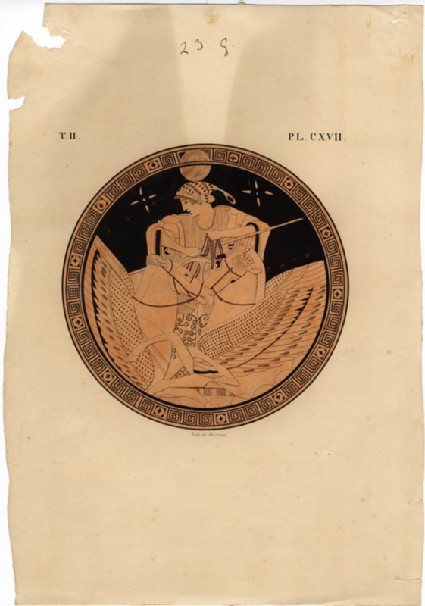Browse: 1470 objects
- Reference URL
Actions
Print of the Decoration on a Greek Cylix, showing Selene P. Bineteau
-
Curator’s description:
Description
The lithograph shows Selene, standing in her chariot and holding the reins of the two winged horses that draw it. It reproduces the decoration of a red-figure cylix in the Berlin Museum (as noted by Cook and Wedderburn, XXI.119 n. 2). The print was plate CXVII in the second volume of Lenormant and de Witte's "Elite des monuments céramographiques", published in 1857. James Dearden, in a personal communication of 28 July 2004, says that he found the plate lying loose at Bembridge, and returned it to the Bembridge copy of Lenormant and de Witte - which was Ruskin's copy of the work, now preserved in the Ruskin Library (inventory no. 1996B2621), and from which the Lenormant and de Witte plates in the collection seem to have been taken: it is missing many of its plates.
The print was first catalogued by Ruskin in 1870, when it appeared as no 23 G in the Educational Series in the "Catalogue of Examples", entitled "Selene in White Clouds at Midnight" and accompanying plates from Lenormant and de Witte representing Selene and Triptolemus. In 1871, it had moved slightly to no. 23 D, placed in Case II, "Elementary Illustrations of Greek Design". It remained in the same position, although renumbered as no. 42, in the 1874 catalogue of the series, but does not appear in Ruskin's 1878 reorganisation of the series. (Cook and Wedderburn's note (XXI.63) that it became no. 41 is incorrect.)
In his entry on the print in the "Catalogue of Examples", and in the instructions in the 1871 and 1874 Educational Series catalogues (pp. 36 and 35, respectively), Ruskin explained how the spots and 'guttae' (drop-like markings) on the horses' wings, and the spirals on the chariot, symbolised clouds' powers of dew, rain and breezes. He explained how the way the moon broke into the border around the image exemplified the 'curious instinct in a good designer to show that he can go beyond his assigned limit'. In the "Catalogue of Examples", he told his students to copy Selene's head in pen.
-
Details
- Artist/maker
-
P. Bineteau (active c. 1857 - c. 1858) (printer)
- Object type
- Material and technique
- watercolour and bodycolour over lithograph on wove paper
- Dimensions
- 350 x 250 mm
- Inscription
- Recto, printed, just outside the border of the image:
top left: T. II.
top right: PL. CXVII.
bottom centre: Lith. de Bineteau
Recto, top centre, in ink: 23. G.
- Provenance
-
Presented by John Ruskin to the Ruskin Drawing School (University of Oxford), 1875; listed as missing in 1906; found by J.S. Dearden at Brantwood and replaced in the original volume; transferred with
- No. of items
- 1
- Accession no.
- LANRL.1996B2621
-
Subject terms allocated by curators:
Subjects
-
References in which this object is cited include:
References
Ruskin, John, Catalogue of the Educational Series (London: Smith, Elder, 1871), cat. Educational no. 23.D
Ruskin, John, Catalogue of the Educational Series (London: Spottiswoode, 1874), cat. Educational no. 42
Ruskin, John, Catalogue of Examples Arranged for Elementary Study in the University Galleries (Oxford: Clarendon Press, 1870), cat. Educational no. 23.G
Lenormant, Charles, and Jean de Witte, Elite des monuments céramographiques: Matériaux pour l'histoire des religions et des moeurs de l'antiquité, 4 vols in 8 (Paris: Leleux, 1844-1861), vol. II, pl. CXVII
Ruskin, John, ‘The Ruskin Art Collection at Oxford: Catalogues, Notes and Instructions’, Edward T. Cook and Alexander Wedderburn, eds, The Works of John Ruskin: Library Edition, 39 (London: George Allen, 1903-1912), 21, cat. Educational no. 42
Location
-
- The Ruskin Foundation





